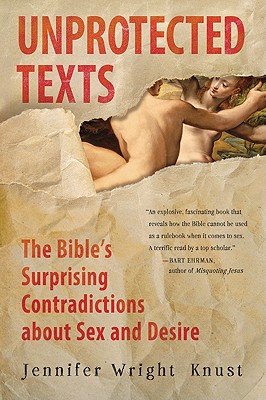 In the introduction of the wittily titled Unprotected Texts, Jennifer Knust offers a revealing comment:
In the introduction of the wittily titled Unprotected Texts, Jennifer Knust offers a revealing comment:
The only way that the Bible can be regarded as straightforward and simple is if no one bothers to read it….The Bible is not only contradictory but complex. Biblical books takes sides, they disagree with one another, they intentionally change earlier teachings, and they make irreconcilable claims about human life and the nature of God. In some cases, they promote points of view that, from a modern perspective anyway, are patently immoral (10).
This excerpt shines light on what is both commendable and what is unhelpful about Knust’s book. She is to be applauded for reminding us that the Bible is not “straightforward and simple,” but is indeed “complex.” Throughout her work, she cites the Bible often, putting before us nothing but the words of the Old or New Testament author.
Seeing such words in their stark reality, staring back at us in our 21st-century coffee shop or kitchen table we are indeed puzzled. Why does Jacob have multiple wives? Why isn’t David stoned for his adultery? Why do some passages of the Bible seem to condone a certain kind of slavery? Knust is right to dive into some of these thorny questions.
Further, she is to be commended for reminding us of the candor of the Word of God. The Lord is willing to say things in His word that we would not repeat in polite company. Menstruation might be a suitable topic for a doctor’s office, but certainly not in church. Knust can sound offensive until you realize she is merely comfortable repeating what our Bible says so clearly.
So, indeed, the Bible is not “straightforward and simple.” It is “complex.” And much of it is at least PG-13, if not rated-R. This much of Knust can be appreciated.
The great weakness of Unprotected Texts is also revealed in our opening quote. She feels that the complexity of the Bible stems from it also being “contradictory.” In fact, ending where she begins, she says that
looking to the Bible for straightforward answers about anything, including sex, can lead only to disappointment. When read as a whole, the Bible provides neither clear nor consistent advice about sex and bodies (244).
This, however, is far from proven in her writing. To the contrary, what is demonstrated on virtually every page of her work is that her conclusions about the Bible are simply reflecting her initial assumptions about the Bible. She begins her reflection on the Bible with the assumption that it contradicts itself, and that it presents a morality that is confusing and often to be ignored by post-Enlightenment thinkers. Through her so-called analysis of the biblical texts themselves she proves the very thing she assumed at the start. In other words, while her work proves the Bible is “complex,” her work only confirms that she believes the Bible is “contradictory.”
Here are some examples.
First, a significant amount of her work is unpacking various meanings that have been given to certain texts. She does this to support her view that the Bible does not fit our tidy, middle-class, conservative values. The profound error here is assuming that if a given text can be interpreted in different ways then the text actually means different things. To put her approach in a different context, if I say, “My house is on fire! Call 9-1-1!”, and you interpret this to mean, “There’s a party at my house tonight, call your friends!” you are not to be commended for finding a second layer of meaning in my words. You are to be confronted for ignoring my clear appeal for help.
As an example, in her reflection on the Song of Solomon, she walks through the famously divergent readings attached to this book. She cites Augustine’s allegorical approach (30) and the even more extreme allegory of Bernard of Clairvaux (33). She adds to these a more conventional reading that rightly points out the sexually charged language of the song (26). However, her own morality finds its way into her interpretation as she wrongly surmises that the poem “displays no interest whatsoever in defending marriage as the only appropriate setting for love” (29). These different approaches will then be used as evidence that interpreters of the Bible have always “found what they wanted” (244). It would appear that it is rather Knust who has found what she wanted.
She misses the essential fact that it is quite possible to interpret the Bible wrongly, to misunderstand its message, to miss the meaning that its words and phrases and structures are intending to convey. That the Bible can be wrongly understood is one of the basic tenets of the Bible itself. Speaking of Paul’s letters Peter makes the point that in these writings “are some things hard to understand, which the untaught and unstable distort, as they do also the rest of the Scriptures, to their own destruction” (2 Peter 3:16). Jesus rebukes the Sadducees because they “are mistaken, not understanding the Scriptures nor the power of God” (Matthew 22:29). If we deny that some interpretations of the Bible are wrong, we go against basic laws of language, common sense, and more importantly, God’s truth itself.
(Note: For a far better interpretation of the Song of Solomon see Tom Gledhill’s The Message of the Song of Songs or Joseph Dillow’s Solomon on Sex).
Second, Knust’s desire to see in the Bible blatant contradictions causes her to read very poorly certain parts of the Bible. Paul is seen as such an example for Knust. Thus, in 1 Corinthians 7 Paul exhorts his readers that “those who have wives should be as though they had none” (v. 29). She finds in this a direct contradiction with Paul’s writing in Ephesians for husbands to love their wives and wives to submit to their husbands. This Colossians-Ephesians morality she calls a “familiar Greco-Roman sexual morality” that contradicts “Paul’s own stated opinions” (100). In other words, for Knust there is no sense that actually both could be compatible truth. The truth is, for those married in the Lord, we are both to live as if Christ was returning today and to share our bodies with one another and live out love and submission in obedience to Christ. These are not contradictions, but Paul emphasizing one truth in one context and another truth in another context.
A third way that Knust misreads the Bible is by missing the history of redemption that we find there. The Bible progresses from the Old to the New Testament, from the old to the new covenant, from the teaching of Moses to the teaching of Jesus. This progression is divinely ordained, not humanly contrived. Within this progression we find a general movement from the physical to the spiritual. God does not give Adam a massive download of truth in the garden of Eden that contains everything the people of God will ever need to know in every situation. Rather, he acts like a loving Father in bringing us along in our understanding of various truths. At times, in fact, the physical events of the Israelites (captivity in Babylon, wandering in the wilderness, sacrificial system, etc.) are meant to instruct us in spiritual principles (blessings on our obedience, temptation in a fallen world, the greater sacrifice of Christ, etc.).
Such a view becomes important when Knust claims the Bible offers contradiction instead of clear teaching, confusion instead of clarity. Thus, the fact that Jacob had multiple wives (Solomon the extreme here) is seen by her as a contradiction to New Testament teachings like 1 Timothy 3:2 where the elder is to be “the husband of one wife.” The inability to see this dimension of the Bible also makes her unable to properly read the cleanliness code of the Old Testament. Where God through this code is communicating part of the essence of holiness and separation, Knust often sees only a primitive people with archaic views of sexuality and the physicality of our bodies (147).
Fourth, she often ties a new reading of a text to a spurious interpretation of a specific word. Ruth, therefore, is seen as soliciting Boaz inappropriately because she is instructed by Naomi to “uncover his feet” (36). Yet, there is nothing in the book of Ruth itself to suggest anything immoral in either Ruth or Boaz. In fact, quite the opposite. The pair are seen as explicitly righteous and honorable in their treatment of one another. It is pure conjecture to see anything else.
Along these lines she tries to defend homosexuality between David and Jonathan because of Saul’s tirade against his son: “You son of a perverse, rebellious woman! Do I not know that you have chosen the son of Jesse to your own shame, to the shame of your mother’s nakedness?” (42). Homosexuality is clearly present in the Bible, but to argue that David takes over the line of Saul because Jonathan has made himself the woman to David the man is simply absurd. The transfer of the dynasty from Saul to David has nothing whatsoever to do with Jonathan. Jonathan is simply the confirmation that Saul’s failure and David’s integrity are legitimate.
The four issues mentioned above give the appearance that there is nothing of merit in Knust’s work. That is not true. She has certainly provided a wealth of research on Jewish, Christian, and ancient secular views on sexuality (and slavery to a lesser extent). At times her use of terms appears offensive until we realize she is being no more explicit than the Bible itself. Knust is also a skilled writer who interacts with all of this material in a clear and compelling manner.
Yet, despite these strengths, the weaknesses of her book are significant enough that she proves a poor guide through the complexities of the Bible’s teaching on sexuality. Her presuppositions that the Bible is non-authoritative, incoherent, and unclear seem to have blinded her to the Bible’s teaching on the sexual ethic we find there: Sexuality is God-given and hard-wired in humans as creatures, and is to be expressed in heterosexual, monogamous marriage and guided by godly self-control. Armed with the presuppositions of Jesus that the Bible is God’s word (Matthew 19:4-5) or of Paul that the Bible is “God-breathed” (2 Tim. 3:16), then Knust’s research could have paid big dividends in seeing the Bible’s teaching against its cultural backdrop. As it stands, her work is better left aside for more reliable guides like Recovering Biblical Manhood and Womanhood (John Piper and Wayne Grudem, Crossway Books).







I found this book to be quite useful in terms of learning some of the apocrophal teachings surrounding these issues. For example; her writing on the Nephilim, i.e. “sex with Angels” being the only sexual act condemned in the Bible, according to Knust’s interpretations.
The book was also useful because it was frankly, comprehensive. It covered every possible passage one could think of which could have bearing on sexuality.
Anyway, I thought I would mention that I found her writing style somewhat alarming throughout. She would often times declare statements along the lines of “this interpretation has since been dismissed by contemorary Bibllical scholars” etc. without a reference or more importantly, an explaination of how it has been contradicted. Such writing practice is alarming because many readers (including myself sometimes) would simply glance over such a statement and soak it in without considering the implications. Furthermore, such statements are not even reliable anyway; as if Knust could speak for all contemporary scholars.
I also was quite alarmed by the fact that a number of Knust’s assertions are based on passages which she translated herself. Perhaps this is a loaded issue (who has the right to interpret, and how could we trust those people?).
This is an absolutely spot on review. I really felt disappointed reading this book. I know that there won’t be a perfect understanding of God’s nature while we are still alive, but that doesn’t mean that we should just resign ourselves to not knowing what God really desires/expects from those who love him. There was a sort of arrogance to the book, and I sort of feel like Knust wasn’t really open to learning or exploring anything she didn’t already know. I personally would have loved to be challenged and inspired, but instead I felt frustrated and patronised. Unfortunately in the end I felt like I couldn’t trust Knust’s logic anymore. What I am struggling with is now trying to find some texts that tackle Biblical sexuality, and I would love to hear any other recommendations you have.
Tash, I felt the same way reading the book. I hope you do find some good guides to help you with the Bible’s teaching on sexuality. I’m not sure which issues you’re wanting to tackle, but the ones I mentioned in the review are good places to start. There are other resources like Ed Wheat’s “Intended For Pleasure,” which is a great overview of biblical sexuality intended for married couples or premarital counseling; Piper and others teamed up for “Sex and the Supremacy of Christ” with a number of great contributors. Once it gets back up and running, the Council on Biblical Manhood and Womanhood will likely have a great website (www.cbmw.org) with a lot of free resources. Must be a big revision they’re doing. Obviously, Covenant Eyes has a lot of helpful information in a straight-forward way. And, honestly, the Bible itself is pretty darn amazing on this topic. It’s a very untapped resource. Reading and re-reading Proverbs 5-9, Song of Solomon, 1 Corinthians 7, 1 Peter 3, and Ephesians 5:22ff. can do a lot to free us to enjoy God’s gift of sexuality on his terms. Hope that helps!
Daniel